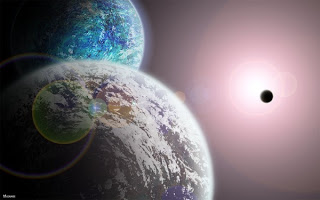 |
| Hubble Space Telescope image of supernova 1987A. The keyhole-like shape at the center is the remnant of supernova explosion 1987A. This remnant is still expanding. It is believed that the surrounding ring was formed before the explosion. // ESA/NASA/P. Challis and R. Kirshner |
Main Point:
Astronomers have found a huge amount of cold molecules and
dust grains in the supernova remnant - Supernova 1987A that surprised them.
Study Further:
Supernova 1987A was reported after an explosion of a massive
star in the year 1987. That star was found in the nearby galaxy, the Large
Magellanic Cloud located about 170,000 light-years away. According to
astronomers, the supernova released about thousand million times more energy
than the energy emitted by the Sun in one year.
Recently, astronomers used the Herschel Space Observatory
and Atacama Large Millimeter/Submillimeter Array (ALMA) to study the supernova remnant
and found huge amount of cold molecules and dust.
"The powerful explosion we saw in 1987 scattered
elements made by the star into space in the form of a very hot plasma,” Mikako
Matsuura from University College London, said in a statement. “The gas has now
cooled down to temperatures between –250° to –170° Celsius [–420° to –275°
Fahrenheit]. That's surprisingly cold, comparable to the icy surface of Pluto
at the edge of our solar system. The gas has formed molecules and some have
even condensed into solid grains of dust. The supernova has now become a super
freezer!"
According to the observations, dust and solid material
produced by the supernova was about 250,000 times the mass of Earth, or
three-quarters of the mass of the Sun.
"We were surprised by the amount of dust and molecular
gas in the reservoir created by the Supernova 1987A,” said Matsuura. “The ALMA
and Herschel observations show that the reservoir contains carbon monoxide
molecules equaling one-tenth the mass of the Sun. Herschel shows that the dust
mass was even larger — about half the solar mass!"
"We don't get many opportunities to study supernovae.
These events are very rare and the majority was found in very distant
galaxies,” said Matsuura. “Even with relatively close ones, like 1987A, it's
difficult. Although they are very bright at the time of the explosion, the
light from the supernovae fades very quickly making it very difficult to
observe them a few years after the explosion. Carl Sagan once said that: 'We
are all made of star-stuff.' These results will help us understand how that
material reached us!"
Source:


+composite+image+shows+the+detection+of+Pluto+largest+moon,+Charon,+cleanly+separated+from+Pluto+itself..jpg)




